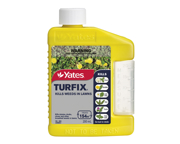Yates Account
Join now
Create a Yates account today!
Sign up to join the Yates Garden Club for monthly e-mails packed with seasonal inspiration, tips for success & exclusive promotions.
Plus if you’re a Garden Club member you can take part in the Yates Growing Community - a blog to share successes, get advice & win prizes in fun challenges along the way!

Forgot password
Enter the email address associated with your account, and we'll email you a new password.
It’s your window of opportunity this moth to head off Onehunga weed. If you had irritating prickles in your lawn last summer, make sure you get Onehunga weed under control before it has a chance to flower and set seed in early spring...basically, you need to kill it before it flowers to stop the prickles from forming.
An application of our Yates Prickle Weedkiller any time before early spring will prevent prickles for next summer.
Also, giving it an extra shot in autumn while the lawn soil is still warm will boost the results of your spring application.
Onehunga weed is easy to identify, it’s a small distinctively ‘ferny’ rosette shaped weed that forms patches through lawn grass. It produces prickly, spiny seeds that you’ll be very familiar with if you’ve had them pin-cushioned into your feet.
Seeds germinate in autumn, but the Onehunga weed doesn’t put on much growth until spring. Flowers are tiny and a greenish-yellow colour. By the middle of spring each rosette of leaves has formed a flower head - unfortunately, this contains lots of ripening seeds with spines on them.
This is why the best time for control is when the plants are putting on their flush of growth during spring; once the flowers form (around October) it’s too late to prevent the prickles. Added to that, once the seed heads have formed, uptake of herbicides is limited and control isn't usually very successful.
Seeds mature and drop from the plant by about the middle of summer. Onehunga weed seed is spread by foot traffic, or on the fur of animals.
Kids and pets (and barefoot adults) will appreciate a summer without prickly feet!















Share
Share this article on social media